1985 William H. Cross Expedition, Sam Houston State Park, Welder Wildlife Refuge, and Kerrville State Park, Texas.
Written by Gary L. Miller and edited by Richard L. Brown
I. Introduction
The 1985 William H. Cross Expedition of the Mississippi Entomological Museum was the first of what is expected to be a long series of unique and rewarding entomological collecting expeditions. The annual Cross Expedition was initiated with contributions to a memorial fund to honor a man who believed that the rigors of field observation and the careful collection, preservation, and study of insects was the basis of understanding the complexities of insect life. In every way this first expedition was a worthy tribute to these ideals and to Bill Cross.
Expedition leader Dr. Paul Lago, a friend of Bill Cross, mirrored the infectious enthusiasm and the pure biophilia that so characterized Bill Cross’s life. Because of his enthusiasm, Dr. Lago was able to guide the expedition at a vigorous and productive pace. Dr. Lago’s persistence as a collector and his interest in and knowledge of different collecting techniques also contributed immeasurably to the success of the expedition.
For Bill Cross, an important part of any field experience was the discussion and debate that arose from observing and wondering about nature. This expedition provided an excellent opportunity for many such intellectual attributes, and ecological characteristics.
Although Bill Cross enjoyed the solitude of nature and spent much time collecting alone, he appreciated good companionship and the sense of comradeship that could come from a shared experience. The 1985 Cross Expedition provided its participants with that sense of family and common purpose. The hours on the road and in the field were often long and the quarters often cramped but there prevailed among the participants a warm good humor and a sense of well being that comes from strengthening friendships. There were no complaints about the food or the accommodations, only a collective pleasure at things observed, conversations shared and discoveries made. Bill would have enjoyed himself.
II. The 1985 William H. Cross Expedition Committee
The Expedition Committee administers the William H. Cross Expedition, allocates a portion of the annually accrued interest from the Expedition Fund for support, and selects the Expedition Leader and other participants. The Committee for 1985 included the following:
Dr. Richard L. Brown, Chairman, Mississippi State University
Ms. Patricia Ramey Miller, Curator of the Mississippi Entomological Museum
Dr. Gerald T. Baker, Mississippi State University
Dr. Michael Ellsbury, USDA
Dr. T. B. Davich, USDA
Dr. Gary L. Miller, Mississippi State University
Mrs. Lou Cross
III. Expedition Leader
The Expedition Leader must be regionally or nationally recognized as a collector and/or specialist with some taxon of Arthropoda, have a broad knowledge of natural history, and have demonstrated collecting excellence. The Expedition Leader has responsibilities of recommending localities for collecting, providing expertise in specialized collecting techniques to accompanying participants, and identifying material in a specialty group collected during the expedition.
Dr. Paul Lago, Associate Professor of Biology at the University of Mississippi, was selected as the 1985 William H. Cross Expedition Leader. Dr. Lago, a native of Iowa, received his M.S. in Biology at Bemidji State University in Minnesota and his Ph.D. in Entomology from North Dakota State University. He joined the faculty of the Department of Biology at the University Of Mississippi in 1976 and was promoted to Associate Professor in that department in 1982.
Dr. Lago is well known for his interest in the systematics of scarabaeid beetles and has published over 27 papers dealing with that interest and other areas of entomology. Dr. Lago is also an accomplished ornithologist.
Dr. Lago and his wife, Barbara, have one son, Eric.
IV. Expedition Participants
Dr. Paul Lago, Professor of Biology, Department of Biology, University of Mississippi. Expedition Leader
Dr. Richard L. Brown, Associate Professor of Entomology, Director of the Mississippi Entomological Museum, Mississippi State University
Dr. Gerald T. Baker, Associate Professor, Department of Entomology, Mississippi State University
Dr. Gary L. Miller, Assistant Professor, Department of Entomology, Mississippi State University
Mr. David Adamski, graduate student, Department of Entomology, Mississippi State University
Mr. Norman Bedwell, graduate student, Department of Entomology, Mississippi State University
Ms. Brenda Booth Brown, student, Department of Entomology, Mississippi State University
Mr. Soowon Cho, graduate student, Department of Entomology, Mississippi State University
Mr. Bobby Farmer, graduate student, Department of Entomology, Mississippi State University
Mr. Malik Khokar, graduate student, Department of Entomology, Mississippi State University
Guest participants: Mr. Peter Kovarik, Texas A&M University (Sam Houston State Park, 12 May); Dr. Edward Knudson, Houston (Kerrville State Park, 16 May)
V. Contributors to the William H. Cross Expedition Fund
R. L. Brown
Miss Betsy Stark
Mr. and Mrs. H. Frere
Dr. and Mrs. T. B. Davich
Mr. and Mrs. Rex Colwick
Charles R. Parencia
Coastal Plain Employees Association, Florence, S.C.
Dr. and Mrs. Lewis R. Brown
Charm R. McIngvale
Staff, Methodist Day School
U.S.D.A. Employees Association, B.W.R.L.
Charlyne C. Jones
Dr. L.B. Davenport, Jr.
Mrs. Louise M. Davis
Herbert Oberlander
Mr. and Mrs. Arlie Wilson
Roy Ollivier
Virginia Ollivier
National Bank of Commerce, Starkville
Mr. and Mrs. Clay Simmons
Dr. and Mrs. H.N. Pitre, Jr.
Jerry Graves
George Sistrunk
Marion T. Loftin
S.O. Hill
Curtis H. Adams
Mr. and Mrs. Henry Stevenson
Dr. and Mrs. Dial Martin
Mr. and Mrs. Homer S. Wilson
Joan B. Chapin
Mr. and Mrs. William E. Pemble
Mobay Chemical Corporation
Mr. and Mrs. Charles Parron
Mr. and Mrs. Paul Fryxell
Phipps Florida Foundation
Mr. and Mrs. J.S. Gainer
Mr. and Mrs. Steven T. Mauldin
Mr. and Mrs. Thomas A. Mauldin
Mr. and Mrs. R.L. Ridgeway
Dr. and Mrs. Howard V. Weems, Jr.
Mr. and Mrs. Alan C. Bartlett
Mr. and Mrs. Joe W. Hagan
Mr. and Mrs. Bryant Mather
Dr. and Mrs. Donald Harlan
Dr. and Mrs. Paul V. Hamilton
E.W. Permenter
Sloan and Lucile Jones
Ray Moore
Edward J. Kuenzler
Mrs. Barbara Gast
Mrs. Lou Cross and Family
R. E. Fye
T.J. Helms
VI. Acknowledgments
Several people who did not participate directly in the expedition provided necessary technical and moral support and deserve mention here. Dr. Mike Ellsbury enthusiastically supported the expedition and contributed many excellent suggestions during the planning phase. Dr. Ellsbury also loaned the expedition his car top carrier. Dr. Randy Luttrell of the Department of Entomology, Mississippi State University, provided a pickup truck from his research program for use by the expedition. Dr. Tom Helms, Head of the Department of Entomology at Mississippi State University, supported the formation of the Cross Expedition. Mrs. Bonnie Adamski helped load the large amount of gear late into the night prior to departure. Mrs. Patricia Ramey Miller provided support by assembling collecting equipment and supplies and by efficiently incorporating the thousands of specimens collected during the Expedition into the holdings of the Mississippi Entomological Museum.
A special thanks is extended to Dr. James G. Teer, Director of the Welder Wildlife Refuge, and to Dr. D. Lynn Drawe, Assistant Director, for the kindness and hospitality extended to the Expedition while it was at the refuge. Mr. David H. Riskind, Head, Resource Management Section, Texas Parks and Wildlife Department, provided permission for collecting at Kerrville State Park. They are worthy guardians of valuable natural areas.
No William H. Cross expedition would have been possible without the support of Mrs. Lou Cross. To a large extent, the success of this first expedition is a result of her strong determination to see it succeed and of the creative and constructive way in which she incorporated the wishes of the Cross family into the planning of the expedition. A warm thank you is extended to her.
VII. Itinerary
12 May 1985-- Starkville, MS to Clinton, MS. Clinton, MS to Marshall, TX then south to Sam Houston State Park (San Jacinto County).
13 May 1985-- Sam Houston State Park, TX to Welder Wildlife Refuge near Sinton, TX (San Patricio County).
14 and 15 May-- Lake Camp on the Welder Wildlife Refuge.
16 May-- Welder Wildlife Refuge to Kerrville State Park near Kerrville, TX.
17 May-- Kerrville State Park, TX to Clinton, MS. Clinton, MS to Starkville, MS.
VIII. Historical Narrative
11 May – During the evening, expedition members Gerry Baker, Dave Adamski, Bobby Farmer and Paul Lago gathered at the Clay Lyle Entomology building (Mississippi State) along with Bonnie Adamski and Patricia Miller to assemble and pack the equipment. The original plan had called for the use of a Mississippi Agricultural and Forestry Experiment Station van and, if necessary, one personal car. Mike Ellsbury had also provided a car top carrier for additional space. A quick survey of the gear, which included four light traps, several large boxes of spreading boards, several boxes of alcohol bottles, cooking gear, food for ten, and six tents, convinced everyone that another vehicle was needed. Several phone calls by Richard Brown secured a covered pickup truck from Dr. Randell Luttrell of the Department of Entomology. The truck had a low mileage engine but high mileage tires and there was some concern about whether it would make the long trip. But having few other options the group decided to worry about breakdowns if they happened and proceeded to load the truck to the brim under the direction of Bobby Farmer who proved to have a talent for assembling and packing gear. After the gear was loaded, the group retired to the local Shoney’s Restaurant for some hot fudge cake and coffee.
12 May-- We had agreed to leave Starkville at 6:30 a.m. and managed to get off at 6:45 a.m. Paul Lago had arranged to join Dr. Bill Stark of Mississippi College in Clinton, MS for a collecting trip to begin several days after the Cross expedition. Clinton was on the Expedition route so Paul followed the van and truck in his car to Clinton. There we left Paul’s car with Bill Stark and proceeded west.
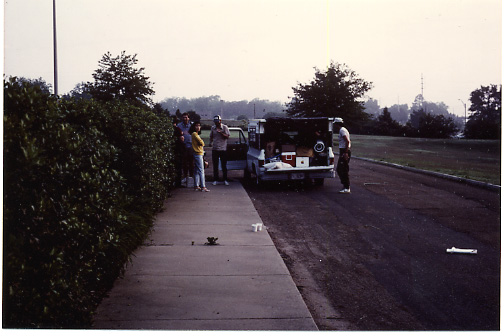
An early morning departure.
Bobby Farmer and Dave Adamski piloted the pickup truck throughout the expedition. The rest of the group rode in the van with Gary Miller or Richard Brown at the wheel.
The trip from Clinton, MS to our first stop at Sam Houston State Park in San Jacinto County, Texas was uneventful except for a brief episode with the truck. We were on I-20 in Louisiana when the assembly holding the spare tire to the underside of the truck broke loose. Our two-vehicle caravan pulled to the shoulder and we quickly jury-rigged a repair and we were on our way.
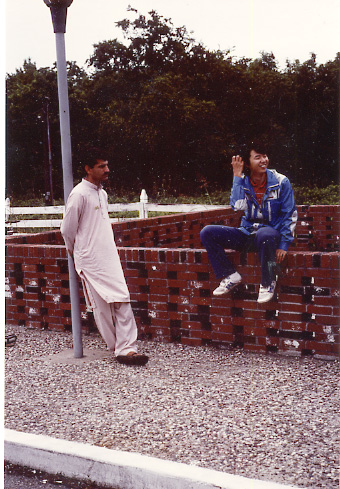
Malik Khokar (left) and Soowon Cho during first lunch stop.
We arrived at Sam Houston National Forest in the evening and set up camp at Double Lake Campground. Gerry Baker and Gary Miller had agreed to be camp cooks and throughout the expedition bravely weathered the many clever and humorous comments regarding the general palatability of the food (or lack thereof). Many comments came from Dave Adamski who, it was noted by many, offered up his opinion of the cuisine only after extensive data collecting with fork and spoon.
The camp cools were not without their shortcomings however. The first night’s dinner consisted of a one-pot chicken and rice dinner that was nearly ruined when Gerry Baker emptied an entire container of garlic salt into the mixture thinking it was only garlic. Gerry and Gary quietly compensated with additional rice and water and everyone ate with considerable gusto. Similar flubs and compensations (too numerous to mention here) were made by the cooks throughout the trip.
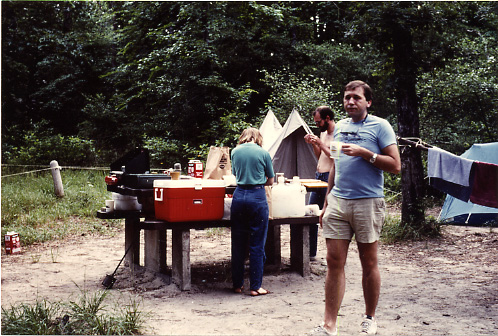
Gerry Baker, expedition chef.
After supper the group dispersed for an evening of collecting. Richard Brown had positioned two sheets with black lights in the woods near camp, and Norman Bedwell had set up a Malaise trap nearby. Dave Adamski and visitor Peter Korvarik from Texas A & M University worked a light at Big Creek. Gerry Baker and Gary Miller spent the evening collecting spiders by headlight. Everyone worked well into the night.
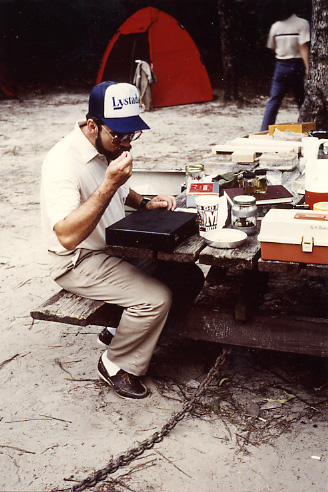
Paul Lago, taking care of insects.
13 May -- The skies were clear early in the evening but the campground was sprinkled by rain several times during the night and the morning brought overcast skies. Everyone was up early to a breakfast of oatmeal, sweet rolls, coffee and orange juice, and stories of an armadillo foraging among the tents in the leaf litter. The showers were ice cold and rat infested but most people braved them anyway.
Most of the morning was spent processing the material collected the night before. Moths had to be spread and other insects pinned and labeled. Paul Lago drove out to check the pitfall traps he had set the previous evening. While most of the group tended to their insects, Gerry Baker, Norman Bedwell and Gary Miller broke camp and packed the van and truck. The work was done and we were off by 11:30 a.m.
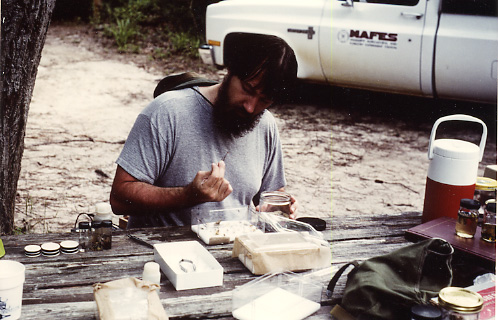
David Adamski, preparing the nights catch at Double Springs Creek Camp.
Since it was near noon by the time we left camp, there was some discussion (some of it quite vehement) about lunch. Some suggested Mexican and Richard, who was driving the van at the time, spotted a small Mexican restaurant in the tiny town of Shepard. We decided to give it a try. The old gentleman who owned the place was quite surprised to see such a large group. He had just opened five days earlier and appeared unprepared to handle so many folks at one time. We ordered, and then several of us went back to the kitchen to lend a hand. Two Mexican women were cooking and the owner, who doubled as the waiter, was fixing drinks from several one-liter soda bottles and a five-pound bag of crushed ice. With our help, we finally got served. The food was spicy and quite good.
We arrived at Welder Wildlife Refuge at around 6:30 p.m. after stopping in nearby Sinton to resupply. Dr. Teer, the Refuge Director, met us and showed us to the Lake Camp area where there was a small cottage that we were to use. The cottage contained several rooms with bunks, a kitchen, and a bath. There was a fenced yard where Norman Bedwell, Bobby Farmer and Gary Miller pitched tents.
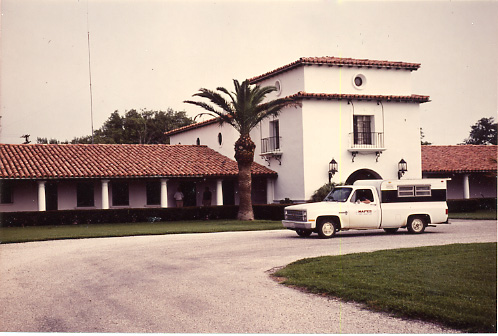
Welder Wildlife Refuge headquarters.
The Lake Camp area was beautiful pastureland with low shrubs and mesquite trees. Welder Wildlife Refuge is a privately endowed natural area. Much of the land is managed for domestic cattle, but many areas are still natural and the wildlife is abundant. We were met at the Lake Camp cottage by a large rat snake and we found several scorpions in the yard. The refuge contains populations of peccaries and alligators and a large number of feral pigs.
Gerry and Gary whipped up a supper of beef stew, salad, and French bread. Everyone ate in hurry so that they could get the light traps set up and scout collecting areas before dark. After supper, Richard Brown, Bobby Farmer and Paul Lago headed toward the southern part of the Refuge near the edge of the Big Thicket to work a light trap. Dave Adamski, Khokar, and Soowon set up several light traps around the cottage.
Norman Bedwell, Gary Miller and Gerry Baker walked down a road toward a nearby lake to collect spiders by headlight. The three made it to the lake (about 1 mile from the cottage) at dusk and started back toward the cottage after dark collecting from the roadside fields as they went. About midway between the lake and the cottage, the group had the first of several encounters reported by expedition members with wild pigs. Gary, who was walking about 10 yards ahead of the other two, spotted a female and several young off to the right side of the road. Almost simultaneously, two large boars ran toward the group the group from the left side of the road. The three beat a hasty retreat to the cottage. The spider collecting was good despite the pig attack.
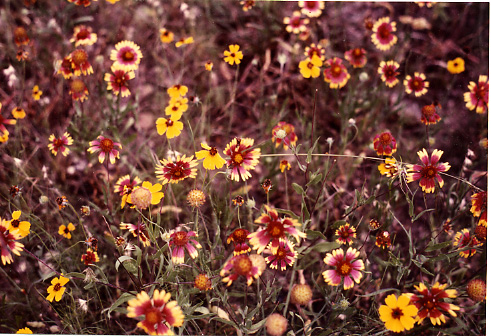
Some common composite flowers at Welder Wildlife Refuge.
14 May – We woke early to the smell of French toast. Gerry had been up since 6:00 a.m. preparing it. Several folks were up even earlier doing a bit of bird watching. Norman Bedwell spotted a Long-eared Owl and several Painted Buntings. Others reported seeing Great Tailed Grackles, Golden Fronted Woodpeckers and Bank Swallows.
The light traps had yielded a tremendous number of insects and Soowon Cho, Dave Adamski, Richard Brown, Paul Lago, and Bobby Farmer were hard at work shortly after breakfast pinning and spreading their catch of the night before. They spent the better part of a day at it. Gary Miller and Gerry Baker spent the morning sweeping some nearby tall grass for insects and spiders.
Visitors to Welder Wildlife Refuge are asked to attend a short orientation concerning the history and activities of the refuge. We thought that a member of the refuge staff would meet us at the cottage this morning to give the orientation but at 11:00 a.m. no one had arrived. Someone suggested that we might have been expected to come to the refuge headquarters for the orientation. So, at around noon, we loaded into the van and headed to the headquarters. We learned there that we had indeed missed our appointment. We arranged another orientation for the following morning at 9:00 a.m.
After lunch, Paul Lago, Bobby Farmer, Gerry Baker and Gary Miller left the rest of the group to their pinning and headed toward town in the van to collect and get supplies. The group collected for much of the afternoon along highway 77 between Sinton and the entrance to the refuge. Paul collected some flightless tiger beetles and other interesting species. Many insects and spiders were taken by sweep net from the roadside vegetation. On the way back to camp the group stopped at a large heavily grazed cow pasture and spent an hour or so digging for dung beetles.
After supper (Chili) everyone loaded into the vehicles to drive out to a wooded area where Richard and Dave had set up three light traps. Just before we pulled out of the cottage driveway, Dr. Teer drove up to tell us that his two hunting dogs, Nick and Gordo, had run away. He asked if we would bring them to him if we spotted them.
We had a productive night of collecting from the light traps and by headlight and most of the group returned to the cottages at around 11:00 p.m. Richard, Dave, and Bobby remained in the field. Around midnight Dr. Teer’s dogs showed up at their collecting site. They captured the dogs and took them back to Dr. Teer’s house (near the refuge headquarters). He was glad to have his dogs back but not as pleased to be awakened at 1:30 a.m.
15 May – We arose early, downed some pancakes, and drove to the refuge headquarters for our 9:00 a.m. orientation. The orientation was interesting. Dr. Teer explained that the focus of the research at the Refuge was primarily wildlife management and range and cattle science. The Welder endowment provides for grants and graduate student work in those areas and the facilities (laboratories, offices, etc.) were excellent.
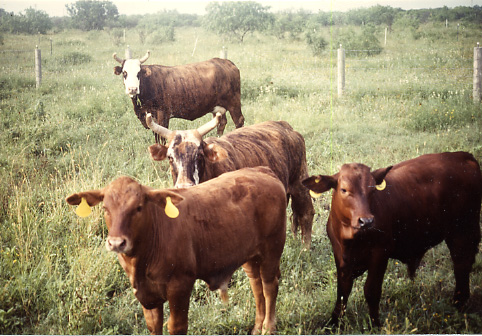
In addtion to feral pigs, peccaries, and alligators at Welder, there were
plenty of cows.
Dr. Teer worked at Mississippi State University briefly after receiving his master’s degree from Iowa State University. While at Mississippi State, he became friends with Mr. Arlie Wilson and Dr. Ross Hutchins, both former entomology faculty members there. Dr. Teer’s wife is from Laurel, Mississippi. After Mississippi State, he went to the University of Wisconsin at Madison for his Ph.D. and then to the faculty of Texas A & M University where he spent 20 years before taking the position at Welder.
After lunch some of the group continued work on processing the thousands of insects collected during the previous two nights. Paul, Gerry, Bobby, and Gary went out to the lake to do some aquatic sampling and then on to find more dung beetles. The aquatic sampling was fair. The group took dredges from about ten locations and collected some nice specimens but did not find anything in large quantities. The group also drove to the river to check some pitfall traps that Paul had set the night before.
Later in the afternoon, Dave and Gary drove to a swampy area near the Aransas River called Hackberry Motte. There they set up a light trap to be used later that evening. The two spotted a large alligators on the riverbank and drove past a large group of wild pigs. The collecting at this location later that evening was poor.
16 May-- We arose early, packed the truck and van, cleaned the cottage and were on our way out of Welder Wildlife Refuge by 8:30 a.m. our destination was Kerrville State Park near Kerrville, Texas, and we made it there by 1:00 p.m.
Dr. Ed Knudson, a physician and amateur lepidopterist from Houston, Texas, joined the expedition for supper and the evening collecting. The group collected under cloudy skies and some spectacular lightning.
Shortly after midnight, after most of the group had turned in for the night, a torrential rain hit the camp. Dave, Paul, and Gary were quickly flooded out of their tents and spent part of the night in the men’s restroom and the rest of the night in the van. Nearly everyone got soaked and, as a result, we were all awake by 7:30 a.m. We packed the wet gear and began the long drive back to Starkville (we anticipated at least 10 hours on the road).
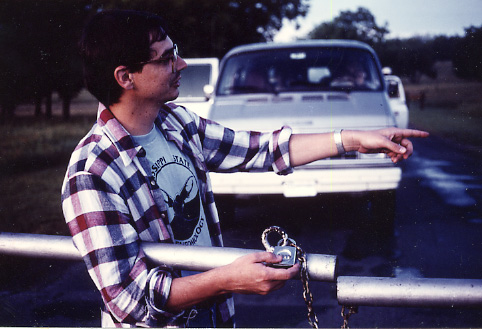
Gary Miller, as the group heads back to Mississippi.
17 May -- The drive back was long and we finally arrived in Clinton, Mississippi around 9:00 p.m. where Bill Stark met us at the local McDonalds. We persuaded one of the McDonalds employees to take a group picture, said our goodbyes to Paul Lago, and pushed on toward Starkville. We arrived in Starkville at 1:15 a.m.
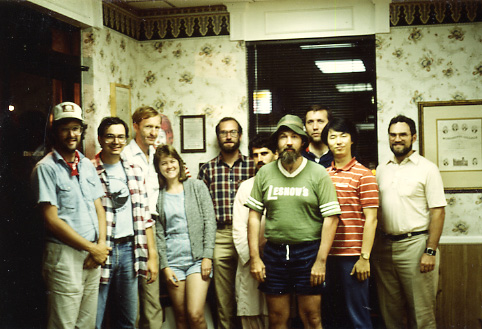
Bobby Farmer (from left), Gary Miller, Richard Brown, Brenda Brown,
Norman Bedwell, Malik Khokar, David Adamski, Gerry Baker, Soowon Cho,
and Paul Lago
IX. Scientific Notes
- New taxa: A new genus and species of Gracillariidae was collected at Welder Wildlife Refuge in San Patricio Co. (Don Davis, personal communication).
- New state record for Texas: Eupragia hospita Hodges (Oecophoridae), San Houston National Forest, 12 May, (News Lepid. Soc., 1986, No. 2: 29).
- New record for Welder Wildlife Refuge: Vitacea admiranda (Hy. Edw.) (Sesiidae) (Blanchard, A. et al. 1985. Southwestern Entomol. 10: 198.).
- Other new taxa and records to be added in future.
This report was written by Gary L. Miller and edited by Richard L. Brown.


